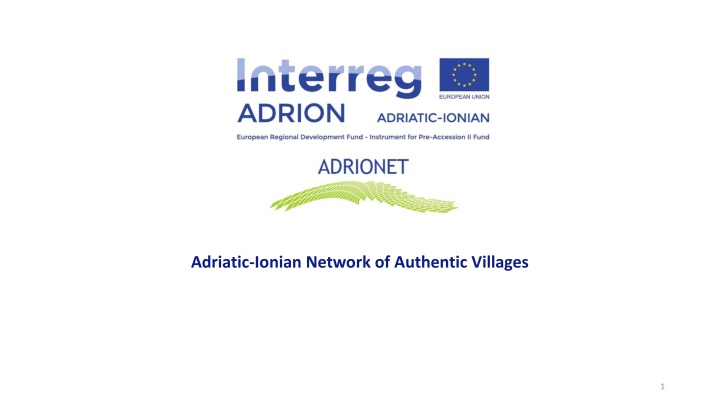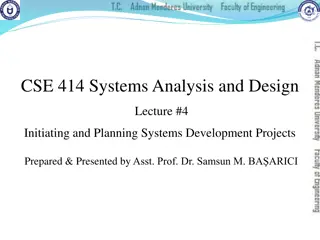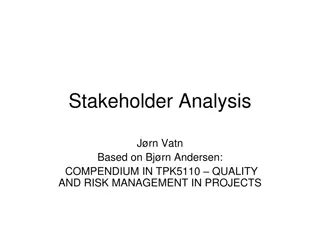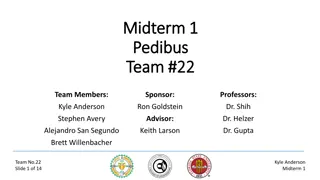
Enhancing Authentic Villages for Sustainable Development
Discover how the Adriatic-Ionian Network of Authentic Villages aims to conserve and enhance small villages rich in cultural and natural heritage. Through transnational cooperation, the project promotes sustainable settlement models and the concept of hospitable communities to revitalize these territories. Learn about the innovative strategies and pilot actions driving the creation of a transnational network of Authentic Villages - Hospital Communities, ensuring long-term conservation and enhancement efforts.
Download Presentation

Please find below an Image/Link to download the presentation.
The content on the website is provided AS IS for your information and personal use only. It may not be sold, licensed, or shared on other websites without obtaining consent from the author. If you encounter any issues during the download, it is possible that the publisher has removed the file from their server.
You are allowed to download the files provided on this website for personal or commercial use, subject to the condition that they are used lawfully. All files are the property of their respective owners.
The content on the website is provided AS IS for your information and personal use only. It may not be sold, licensed, or shared on other websites without obtaining consent from the author.
E N D
Presentation Transcript
1. The territories involved in ADRIONET The territories involved in Adrionet are full of small authentic villages, often located in extraordinarily beautiful places (river basins, mountains, hills, peripheral rural or marginal areas), in some cases at risk of depopulation and abandonment, These villages represent an asset of social, cultural and environmental primary omportance, a repository of local micro-stories and identities, productive know-how, food and artisan traditions, which should be more and more intensely involved in regional strategies and actions for conservation and enhancement, through models of sustainable settlement that enhance the existing cultural and natural heritage. 2
2. The general objective of the project The main project objective is to overcome the current marginalization, fragmentation and under-enhancement of these territories through the promotion at transnational level of a development model based on social, environmental and economic sustainability, also achieved through the conservation of natural and cultural heritage. The project actions consist in the definition of a transnational strategy and in the realization of some pilot actions which will culminate in the creation of a transnational network of Authentic Villages - Hospital Communities, which will become permanent and operational even after the end of the project. Together with this, an online platform will be created to collect, document and disseminate the best European experiences on the integrated processes of territorial enhancement of natural and cultural landscapes in fragile and vulnerable territories. 3
3. Villages as hospitable communities All this will be achieved through the local dissemination of the innovative concept of "hospitable community", in which the community itself assumes the role of driving force for local development; and organizing a widespread, professional welcome around its resources and values, able to make visitors live unique experiences and to remember when returning from the trip. Through a series of pilot actions, territory by territory, common solutions of territorial enhancement will be tested on the basis of a model of "authentic village". This model is pursued and practiced in Italy by the Associazione Borghi Autentici d'Italia, BAI (partner of Adrionet), a network of small and medium-sized municipalities constantly committed to improving and preserving the environmental quality, the quality of life of the resident population and enhancing the territories through a respectful use of the environment, its resources and its cultural, social prerogatives as well as its tourist vocations. Transnational cooperation will allow the networking of small scattered villages of the ADRION region and their transnational visibility. 4
4. The participation of the inhabitants The participation and involvement of the inhabitants will be a central aspect of the entire project, through the promotion of real hospitable communities, understood as a set of local actors (public administrations, citizens, economic operators) interested in systematising and improving the network of available services, primarily for residents, and then for tourists. 5
5. Pilot actions to enhance villages: horizontal action Pilot actions shall create the conditions for the construction and functioning of the local coalition of actors (restaurants, hotels, producers, shops, associations, guides, local administration, travel agencies, etc.) able to "organize" the tourist destination, manage the proposal of integrated tourist offers, implement and innovate experiential tourist offers, constantly communicate within and outside the territory the tourist and fruition proposals. 6
6. Pilot actions to enhance the villages: demonstration actions Local demonstration pilot actions will focus, by way of example, on: enhancement of the cultural and natural heritage through integrated fruition experiences, for example between museums, archaeological sites, natural areas, local producers, also with the application of innovative technologies; creation of experiential tourist proposals that also enhance the local know- how and the desire to learn skills-manual skills, production techniques from visitors (bread, pasta, traditional local dishes, woodworking, knitting, participation the collection of agricultural products, etc.); 7
7. Pilot actions to enhance the villages: demonstration actions Local demonstration pilot actions will focus, by way of example, on: introduction of new services / creation of "service networks" fueled by "active citizenship" practices, aimed in particular at improving the quality of hospitality towards visitors (for example, transport by call, single ticket to cultural sites, assistance of various kinds) the design and installation of integrated information services / systems / products (road signs of places to visit) suggestions from partners, with respect to the needs of their territories. 8
8. The initial role of the partners: the choice of the pilot areas The individual regional authorities must first identify specific regional pilot areas in which the transversal activities of the project will be carried out, in order to test the various initiatives in these territories, and in order to then be able to replicate them in other areas of the country with similar characteristics. The small scattered villages located in the territories concerned, alone, do not have size, experiences, skills and competences, necessary to achieve the main objective of the project: while the profile of the regional organizations is appropriate to start and manage the commissioning network of local processes, to support them from an institutional and financial point of view, and to create the first level of authentic villages. 9
9. Criteria for choosing pilot areas The pilot areas must be homogeneous, characterized by the presence of villages, small and medium-sized municipalities of up to 15,000 inhabitants, located in landscapes of great environmental importance (river and lake basins, mountain and hilly areas, rural areas) which often turn out to be in a condition of peripherality and marginality, in some cases at risk of depopulation and abandonment. The choice of the pilot areas must be made following the logical thread of the territorial contiguity with which to associate natural elements (for example river auctions or parts of them), or historical, cultural, and productive elements, which characterize them or may be able to characterize them if overall valued and made known to potential tourists. Given the presence of these villages, they must be areas that represent principals of social, cultural and environmental primary importance and safeguard a heritage of local identities, productive know-how and food and wine and craft traditions capable of activating models of sustainable development. 10
10. Timing and indications for the choice of pilot areas Each partner must identify and apply for an area comprising at least 3 rural municipalities, located in areas of great environmental importance (river and lake basins, mountain and hilly areas), belonging to the same territorial socio- economic system, in order to achieve the project target value (35 municipalities involved, among all partners). The important thing is that it shall be a homogeneous area (with similar characteristics), rural, and engageable because of its potential for tourism development and enhancement. Each Partner must identify the pilot territories by May 15, 2020 (by returning the enclosed application form to BAI). On the occasion of the kick-off meeting, each Partner will present the territorial characteristics to all others. It is suggested to use descriptive slides, with photos of the territory and villages. Maximum time for presentation: 5 minutes. 11






















